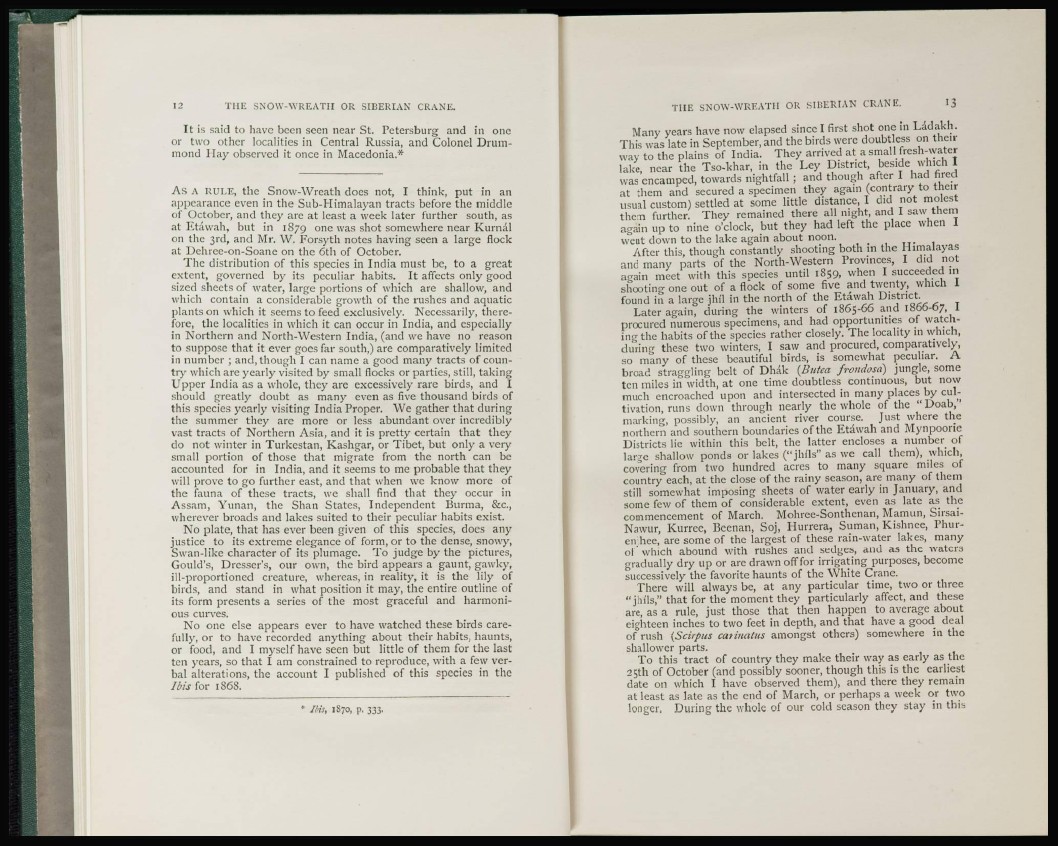
It is said to have been seen near St. Petersburg and in one
or two other localities in Central Russia, and Colonel Drummond
Hay observed it once in Macedonia.*
As A RULE, the Snow-Wreath does not, I think, put in an
appearance even in the Sub-Himalayan tracts before the middle
of October, and they arc at least a week later further south, as
at Etawah, but in 1879 one was shot somewhere near Kurnal
on the 3RD, and Mr. W. Forsyth notes having seen a large flock
at Dehree-on-Soane on the 6th of October.
The distribution of this species in India must be, to a great
extent, governed by its peculiar habits. It affects only good
sized sheets of water, large portions of which are shallow, and
which contain a considerable growth of the rushes and aquatic
plants on which it seems to feed exclusively. Necessarily, therefore,
the localities in which it can occur in India, and especially
in Northern and North-Western India, (and we have no reason
to suppose that it ever goes far south,) are comparatively limited
in number ; and, though I can name a good many tracts of country
which are yearly visited by small flocks or parties, still, taking
Upper India as a whole, they are excessively rare birds, and I
should greatly doubt as many even as five thousand birds of
this species yearly visiting India Proper. We gather that during
the summer they are more or less abundant over incredibly
vast tracts of Northern Asia, and it is pretty certain that they
do not winter in Turkestan, Kashgar, or Tibet, but only a very
small portion of those that migrate from the north can be
accounted for in India, and it seems to me probable that they
will prove to go further east, and that when we know more of
the fauna of these tracts, we shall find that they occur in
Assam, Yunan, the Shan States, Independent Burma, &c,
wherever broads and lakes suited to their peculiar habits exist.
No plate, that has ever been given of this species, does any
justice to its extreme elegance of form, or to the dense, snowy,
Swan-like character of its plumage. To judge by the pictures,
Gould's, Dresser's, our own, the bird appears a gaunt, gawk)',
ill-proportioned creature, whereas, in reality, it is the lily of
birds, and stand in what position it may, the entire outline of
its form presents a series of the most graceful and harmonious
curves.
No one else appears ever to have watched these birds carefully,
or to have recorded anything about their habits, haunts,
or food, and I myself have seen but little of them for the last
ten years, so that I am constrained to reproduce, with a few verbal
alterations, the account I published of this species in the
Ibis for 1868.
* ms, 1S70, p. 333.
Many years have now elapsed since I first shot one in Ladakh.
This was late in September, and the birds were doubtless on their
way to the plains of India. They arrived at a small fresh-water
lake, near the Tso-khar, in the Ley District, beside which I
was encamped, towards nightfall ; and though after I had fired
at them and secured a specimen they again (contrary to their
usual custom) settled at some little distance, I did not molest
them further. They remained there all night, and I saw them
again up to nine o'clock, but they had left the place when I
went down to the lake again about noon.
After this, though constantly shooting both in the Himalayas
and many parts of the North-Western Provinces, I did not
again meet with this species until 1859, when I succeeded in
shooting one out of a flock of some five and twenty, which I
found in a large jhil in the north of the Etawah District.
Later again, during the winters of 1865-66 and 1866-67, I
procured numerous specimens, and had opportunities of watching
the habits of the species rather closely. The locality in which,
during these two winters, I saw and procured, comparatively,
so many of these beautiful birds, is somewhat peculiar. A
broad straggling belt of Dhak (Bntca frondosa) jungle, some
ten miles in width, at one time doubtless continuous, but now
much encroached upon and intersected in many places by cultivation,
runs down through nearly the whole of the " Doab,"
marking, possibly, an ancient river course. Just where the
northern and southern boundaries of the Etawah and Mynpoorie
Districts lie within this belt, the latter encloses a number of
large shallow ponds or lakes ("jhils" as we call them), which,
covering from two hundred acres to many square miles of
country each, at the close of the rainy season, are many of them
still somewhat imposing sheets of water early in January, and
some few of them of considerable extent, even as late as the
commencement of March. Mohree-Sonthcnan, Mamun, Sirsai-
Nawur, Kurree, Beenan, Soj, Hurrera, Suman, Kishnee, Phurenjhee,
are some of the largest of these rain-water lakes, many
of which abound with rushes and sedges, and as the waters
gradually dry up or are drawn off for irrigating purposes, become
successively the favorite haunts of the White Crane.
There will always be, at any particular time, two or three
"jhils," that for the moment they particularly affect, and these
are, as a rule, just those that then happen to average about
eighteen inches to two feet in depth, and that have a good deal
of rush (Scirpus Cat hiatus amongst others) somewhere in the
shallower parts.
To this tract of country they make their way as early as the
25th of October (and possibly sooner, though this is the earliest
date on which I have observed them), and there they remain
at least as late as the end of March, or perhaps a week or two
longer, During the whole of our cold season they stay in this